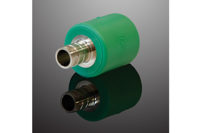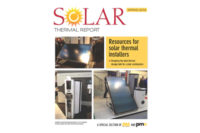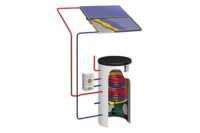Residential solar combisystems provide domestic water heating and some percentage of space heating. Although less known than domestic hot water-only systems, combisystems can be practical and efficient if properly sized and designed.
During the first solar era in the United States, solar combisystems were designed to provide a high percentage of the space-heating load, even in marginal northern climates. Roof tops were covered with collectors and basements housed 1,000 to 2,000 gal. storage tanks. Eventually these systems proved to be “solar monuments” rather than practical, repeatable solutions. They gave certain well-healed owners bragging rights and qualified for government subsidies while they were available for the taking.
Today, I like to describe properly proportioned solar combisystems as “domestic hot water plus.” The “plus” refers to the system’s ability to provide a small percentage of space heating, primarily during spring and fall. The approach leverages the favorable economics associated with solar domestic water heating as the base load, yet recognizes that such systems can be extended to assist with space heating during swing-season conditions. It also prevents grossly oversized solar collector arrays that bring constant concern for overheating during warmer months.
Solar combisystems can be designed around either unpressurized or pressurized thermal storage tanks. Both approaches have advantages and limitations. From the standpoint of optimizing thermal efficiency, systems using pressurized tanks tend to have the edge. The reason is that they can connect directly to a hydronic distribution system without an intervening heat exchanger and the thermal penalty associated with it. If the collector subsystem uses drainback freeze protection, the same water that flows through the collectors also flows through the thermal storage tank and the hydronic distribution system. The only heat exchanger required is for separating domestic water from system water.
Tanks needed
One of the current difficulties associated with designing solar combisystems is the availability of suitable thermal storage tanks. Although tanks are available for established applications such as high-volume domestic water heating, buffering and storage, they often lack the number of connections, connection placement or insulation that would be ideal for solar thermal applications.
Of course, a custom tank can be built for a specific application. However, this gets expensive and often requires significant lead time. There’s also less chance that a custom tank can be delivered as a pre-insulated product.
So, if a manufacturer wanted to create the “ideal” tank for a residential solar combisystem, what would it look like? I’m sure there would be plenty of opinions on this that weigh issues such as production cost, available tooling, size options, insulation options and what connections should be provided.
Here are my thoughts, and the reasons behind them.
First, all thermal storage tanks should encourage temperature stratification. Ideally, they should be vertically oriented and have multiple, generously sized piping connections along their vertical dimension. This allows water at different temperatures to flow into and out of the tank without major disruption of temperature stratification. The piping connections on the tank must work in concert with stratification.
Flows entering the tank should do so with minimal disturbance of temperature stratification. This may require internal baffles or perhaps an internal “distributor tube” with multiple horizontally oriented holes that gently release water in a horizontal direction.
The tank volumes needed for residential solar combisystems typically fall in the range of 200 gal. to 400 gal., assuming a nominal 2 gal. of storage per sq. ft. of collector area. These volumes could be accommodated by unlimited combinations of diameters and heights. However, I think one of the most practical design constraints is that the tank must fit through a 36-in.-wide doorway. Thus, if the tank is supplied pre-insulated, the outer shell should not have a diameter of more than 35 in.
A cylindrical pressure vessel that has a diameter of 29 in. and is 80 in. tall would have a volume of about 229 gal. Assuming 3-in.-thick insulation on all surfaces, the final assembly would have a 35 in. diameter (able to fit through a 36-in.-wide doorway) and be 86 in. tall (able to fit within a typical residential basement, which is typically about 93.5 in. from the top of the slab to the underside of the framing). The overall height of 86 in. would leave a few inches to spare for hardware mounted at the top of the tank.
One tank of this size would be a good match for three 4 ft. x 10 ft. collectors. Two tanks, closely coupled side by side, could handle twice this collector area.
Where can I buy this?
Figure 1 (page 40) shows two tank concepts I think would be ideal for residential combisystems. They could be used with solar thermal collectors, as well as other renewable heat sources such as wood-gasification boilers. The tank on the right is the same as the tank on the left, but includes a generously sized stainless-steel internal heat exchanger for domestic water heating.
This tank (with or without the internal heat exchanger) would be for use in a closed hydronic system. To reduce cost, it could be constructed of carbon steel rather than stainless steel. It would not need a glass lining. The pressure vessel would be tested to 60 psi, twice the working pressure of most residential and light commercial systems equipped with 30 psi relief valves.
I’ve shown internal baffles a couple inches inside the piping connections that carry flow into the tank. These are curved plates, which are concentric with the pressure vessel. They prevent incoming flow from “jetting” across the tank, which tends to disturb temperature stratification. Another possibility would be the use of horizontal flow distributor tubes that thread into the tank’s inlet connections.
The tank would have heavy thermal insulation (e.g., a minimum of R-18 foam insulation on all surfaces). This would likely require 3 in. of polyurethane insulation. I’m a firm believer in making thermal storage tanks perform like Thermos bottles when it comes to heat loss. These large tanks have plenty of surface area and it seems imprudent to allow anything more than a “trickle” of jacket heat loss. Nobody wants a thermal storage tank leaking heat into his home on a hot sunny day when the solar collectors have heated it to 175º F and the home’s cooling system is running full tilt.
Piping connections would be provided on the sides near the top, middle and lower regions of the tank. They would be sized for 2-in. piping, which allows for minimum flow restriction. If smaller piping is needed, just install reducer bushings. These larger connections also could accommodate horizontal flow distributor tubes that carry flow into the tank with minimal disruption of stratification (assuming that internal baffles were not used).
The tank would have at least one 3/4-in. connection at the top to allow for air venting, as well as a pressure relief valve. Additional 3/4 in. FPT connections would be provided for sensor wells in the upper and lower regions of the tank. If necessary, multiple sensors could be accommodated within each of these wells.
Two of these tanks should be capable of being connected side by side at the upper, middle and lower connections, as shown in Figure 2. A short connector with a stainless-steel bellows would allow for slightly misaligned connections, which are likely given the less-than-perfectly flat surfaces of most concrete floors. These connectors also would reduce mechanical stresses that might otherwise be imposed by rigid connectors.
Anchor component
Figure 3 (page 42) shows one way to configure a residential combisystem system around the tank shown on the right side of Figure 1.
This antifreeze-protected solar subsystem works on the coolest water in the lower portion of the tank. This improves collector efficiency and preserves stratification (e.g., leaves the hottest water undisturbed at the top of the tank).
The water temperature in the upper portion of the tank is maintained by the boiler so that domestic water can be fully heated in one pass through the internal stainless-steel heat exchanger. Cold domestic water enters at the bottom of this heat exchanger and passes upward. The coil area is “biased” toward the top of the tank to take advantage of the higher tank temperatures.
This provides counterflow heat exchange, as well as a higher log mean temperature difference between the tank water and the warming domestic water. Heated domestic water passes from the coil to the hot port of an ASSE 1017-rated thermostatic mixing valve. This prevents excessively high domestic hot water delivery temperatures during times when the solar array has heated the storage water to high temperatures.
Water for space heating is drawn from near the top of the tank. It passes through a three-way motorized mixing valve that protects the low temperature distribution system from excessively high temperatures and provides outdoor reset control of the supply water temperature. The thermal mass of the upper portion of the storage tank buffers what could be a highly zoned hydronic distribution system, thus preventing the boiler from short-cycling under partial load conditions.
Figure 4 shows how the tank could be configured with an external heat exchanger for domestic water heating.
In this configuration, a flow switch detects a draw for domestic hot water and responds by turning on a small circulator that moves hot water from the top of the storage tank through a stainless-steel, brazed-plate heat exchanger. As with the previous system, water at the top of the storage tank is maintained at a suitable temperature so that a single pass through this heat exchanger provides the full temperature lift needed to produce domestic hot water.






